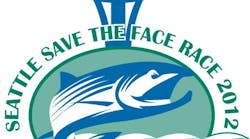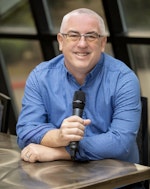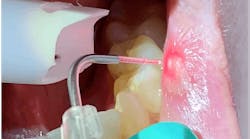As we’re all hopefully aware by now, oral cancer will kill one American every hour of every day. According to the Oral Cancer Foundation, the death rate associated with this cancer is particularly high not because it is hard to discover or diagnose, but because the cancer is routinely discovered late in its development.
To help raise awareness of the importance of early detection, a Seattle dental practice (Pike Place Dental) has partnered with the Oral Cancer Foundation to organize Seattle’s first-ever oral cancer awareness event — the Seattle Save the Face Race.
The Seattle Save the Face Race is scheduled for Saturday, Oct. 20, and will be held at
Seattle’s Seward Park along the shores of Lake Washington. It will include free oral cancer screenings for the public, and all proceeds will benefit the Oral Cancer Foundation.
As an incentive for Seattle-area dental practices, LED Dental is offering a free Velscope VX (a $3,200 value) to the top earning dental practice.
I recently talked with Mike Thierbach RDH, the event coordinator, and Eric Statler, a Stage IV oral cancer survivor who is now the Director of Strategic Partnerships for The Oral Cancer Foundation, about the Seattle Save the Face Race.
Kevin Henry: What was the genesis behind starting the Save the Face Race?
Mike Theirbach: I am the hygienist for Dr. Kent de Vigne at Pike Place Dental in Seattle. Dr. de Vigne has always had a passion for oral cancer awareness and that passion was multiplied when we learned all the disturbing statistics about the increase in the death rate due to HPV. We were one of the first Seattle offices to use a Velscope and are (unfortunately) still one of few who do. There just seems to be a lack of awareness among the general population and even among the dental community. It is because of this that Dr. de Vigne made it his mission to reduce the rates of oral cancer in the Seattle area before he retires. As his hygienist, I perform the vast majority of our office’s oral cancer screenings. Luckily I have yet to find a cancerous lesion, and I don’t want to be the one to miss the lesion that is.
Henry: Talk about building a program in its first year and some of the challenges and successes you have had.
Eric Statler: The challenges to raising awareness for a first-year walk and getting it off the ground are many. Getting a committed core group of volunteers who are both passionate about the cause and willing to take the time to make the event a success is very difficult. Due to my connections in the Seattle area — I’ve lived there for 13 years, my wife is a native, and most of our family lives in the area — I have a lot of connections — personal, business, and in the oral cancer community.
The successes we've had may be too many to list, however, the relationships built with the Richardson Group, VELscope, and the Washington State Dental Association, and having Boeing add us to their community-giving program, are the successes I think I would highlight. So many great relationships were formed from those connections that have helped give credibility to the event.
Thierbach: To build on what Eric said, one challenge has been getting a solid group of committed volunteers who are willing to put in the “grunt work.” We are blessed to have that group with us now. Secondly, just jumping through all the hoops, making the contacts, and managing all the logistics that go along with an event of this size has been a huge challenge. I know this is something that will get significantly easier in our second year, so it’s all about working hard now and learning from our mistakes and setbacks.
Henry: What are the goals for this year's event?
Statler: My goal for every event I've participated in has been to raise the maximum public awareness possible. People are dying and they don't have to be. The demographics of oral cancer have changed dramatically over the past two decades, catching the medical and dental communities, and the general public, unaware. Tobacco is no longer the No. 1 cause of oral cancer. HPV is, and the fastest growing demographic for oral cancer is young people between the ages of 20 and 40, who have none of the "traditional" risk factors for the disease.
Oral cancer has a 61% overall survival rate. However, if caught early, it's more than 90% with very little effect on long-term quality of life. With the help of our medical and dental communities, and with our corporate sponsors getting the word out, we can make a real impact on both the survival rates and long-term quality of life by raising awareness and early detection.
Henry: What have other oral cancer fundraising events around the nation taught you?
Statler: Having spoken at two of the largest Oral Cancer Awareness walks this year, and having friendships with those organizers, we've learned quite a bit and have been fortunate to be able to draw from their experiences.
The Seattle walk has been put together rather quickly; we've only had six months to plan it, where generally a year is recommended. I think we've been able to do that because of the strong relationships within the dental community.
I've been a volunteer for the Oral Cancer Foundation for more than three years now and I’ve noticed that the events that have strong support from area dental communities have the biggest impact, and you don't have to look farther than the N. Illinois Oral Cancer Awareness walk for an example. That walk was organized entirely by RDHs, with Allison Stahl as the head. Her first-year event in June was the largest awareness walk OCF has ever had, and it was a complete success. We've taken notes for sure, and I'm thankful to call Allison a friend. I’ve drawn on her experience to help with the Save the Face Race.
Thierbach: This is my first time to ever put anything like this together, so the input and advise from the Oral Cancer Foundation and their collective experiences has been invaluable. Everyone within the OCF has been so incredibly helpful. And watching the Illinois walk turn into the massive success that it was is very inspiring for me. If they could do it, why shouldn’t we?
Henry: Are you finding people are more aware of oral cancer than in the past?
Statler: This year in particular has been a very successful year for the Oral Cancer Foundation Awareness campaigns. Our partnership with the Bruce Paltrow Oral Cancer Fund, and Michael Douglas coming on board to do a public service announcement, have really raised the profile of this disease. However, we have a long way to go. Right now we’re trying to get ahead of the massive shift in demographics due to HPV, which according to Dr. Maura Gillison of Ohio State University accounts for 60% of new oral cancer cases. We have a long road ahead of us, so we need all the help we can get before we'll see big improvements in survival rates.
Thierbach: I am encouraged by all the national recognition that oral cancer has been given lately. As a dental provider I am still saddened by the lack of awareness - not a lack of awareness of the existence of oral cancer, but a general lack of awareness regarding the etiology of this disease. Most people I talk to in the dental chair are shocked to learn about the HPV connection. Most 20-something-year-old non-smokers have not even considered that they may be at risk for oral cancer. But my hope is that through all the success we are having with this walk that we will generate more interest and raise some awareness.
Editor's Note: For more information, you can reach Thierbach at [email protected] or visit www.savethefacerace.com.







